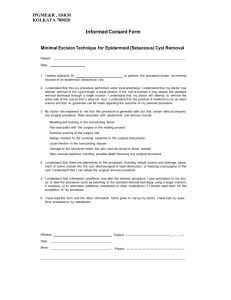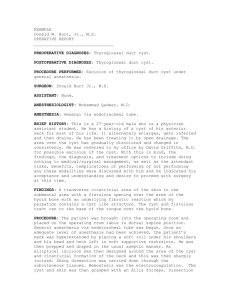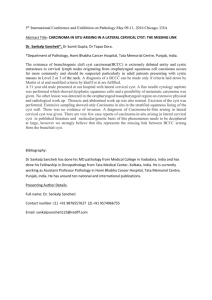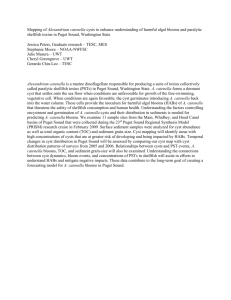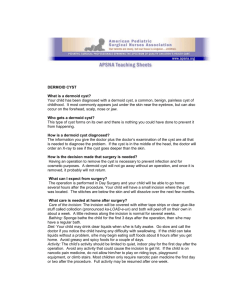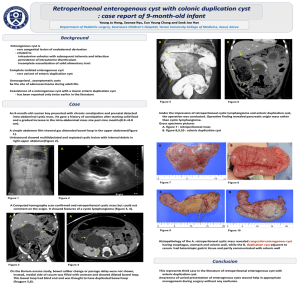ORAL PATHOLOGY.Test
advertisement
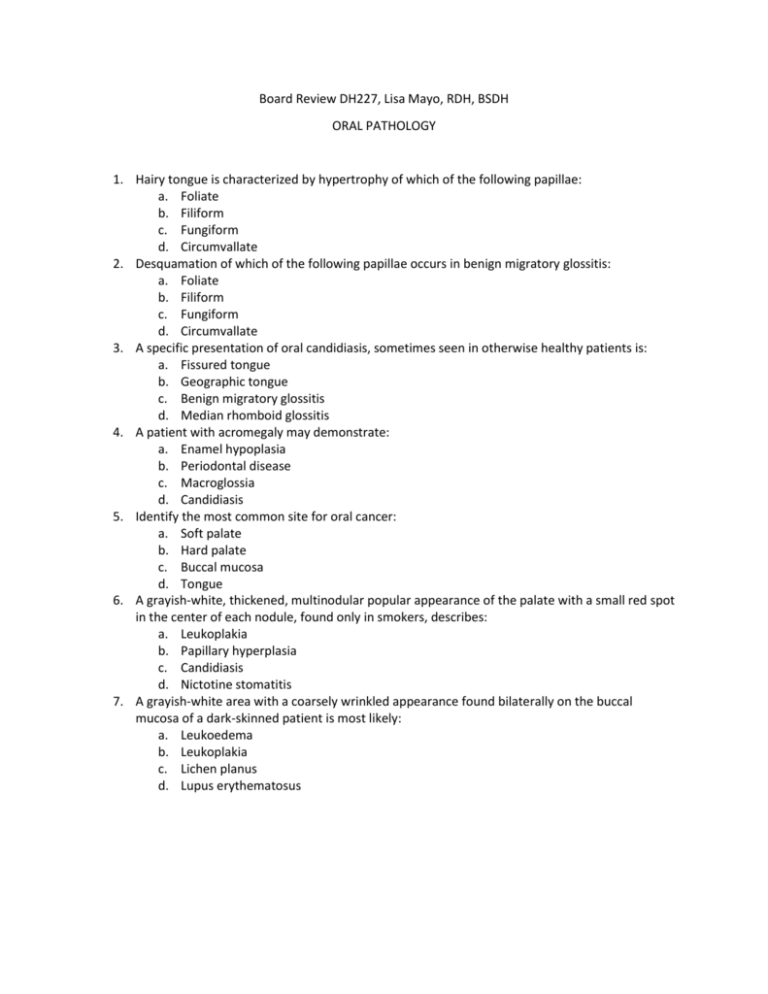
Board Review DH227, Lisa Mayo, RDH, BSDH ORAL PATHOLOGY 1. Hairy tongue is characterized by hypertrophy of which of the following papillae: a. Foliate b. Filiform c. Fungiform d. Circumvallate 2. Desquamation of which of the following papillae occurs in benign migratory glossitis: a. Foliate b. Filiform c. Fungiform d. Circumvallate 3. A specific presentation of oral candidiasis, sometimes seen in otherwise healthy patients is: a. Fissured tongue b. Geographic tongue c. Benign migratory glossitis d. Median rhomboid glossitis 4. A patient with acromegaly may demonstrate: a. Enamel hypoplasia b. Periodontal disease c. Macroglossia d. Candidiasis 5. Identify the most common site for oral cancer: a. Soft palate b. Hard palate c. Buccal mucosa d. Tongue 6. A grayish-white, thickened, multinodular popular appearance of the palate with a small red spot in the center of each nodule, found only in smokers, describes: a. Leukoplakia b. Papillary hyperplasia c. Candidiasis d. Nictotine stomatitis 7. A grayish-white area with a coarsely wrinkled appearance found bilaterally on the buccal mucosa of a dark-skinned patient is most likely: a. Leukoedema b. Leukoplakia c. Lichen planus d. Lupus erythematosus 8. A 50-year old male pipe smoker has lesions on his palate, underneath his denture. He removed his denture only to clean it. The lesions are erythematous, papillary projections. His CC is illfitting dentures. The patient most probably has: a. Stomatitis nicotinia b. Traumatic ulcers c. Papillary hyperplasia d. Candidiasis 9. Prolonged antibiotic therapy predisposes a patient to which of the following diseases: a. Candidiasis b. Dental caries c. Herpes simplex virus d. Recurrent aphthous ulcers 10. You notice a reddened mucosa underneath a patients removable partial denture; the most likely cause of this appearance is: a. Aphthous ulcers b. Candidiasis c. Papilloma d. Papillary hyperplasia 11. Patients with removable dental prosthesis are more likely to develop candidiasis. Treatment of the candidiasis must include the oral cavity as well as the denture to prevent recurrence. a. Both statements are true b. Both statements are false c. The first statement is true, the second is false d. The first statement is false, the second is true 12. Forcydes granules can be classified as: a. Sebaceous glands b. Salivary glands c. Granulation tissue d. Lymph nodes 13. Identify an oral manifestation of Addison’s Disease: a. Inflamed gingiva b. Pigmentation c. Hypoplastic enamel d. Hyperplastic granuloma 14. Which of the following conditions is frequently seen in pregnant patients: a. Peripheral giant cell granuloma b. Gingival fibrous hyperplasia c. Epulis fissuratum d. Pyogenic granuloma 15. Clinically and microscopically, the epulis fissuratum is most similar to: a. Papilloma b. Irritation fibroma c. Condyloma d. Giant cell granuloma 16. Which drug does not cause gingival hyperplasia: a. Phenytoin b. Cyclosporine c. Nifedipine d. Inderal 17. Which of the following intraoral locations is the most common site for formation of a pyogenic granuloma: a. Tongue b. Palate c. Gingiva d. Buccal mucosa 18. Clinically, the peripheral giant cell granuloma most closely resembles the: a. Pyogenic granuloma b. Papilloma c. Cementoma d. Mucocele 19. The coxsackie virus is responsible for: a. Infectious mononucleosis b. Herpangina c. Herpes labialis d. Aphthous ulcers 20. Your patient is a 6 year old who presents with swollen lymph nodes, red, painful oral lesions and a high fever. Identify the condition associated with these symptoms: a. Primary herpetic gingivostomatitis b. Herpetic whitlow c. Herpes simplex 2 d. HIV 21. Herpetic whitlow may be prevented by the use of: a. Protective eyewear b. Mask c. Gloves d. Sterile instruments 22. Identify the virus that causes infectious mononucleosis: a. Coxscakie virus b. Herpes simplex virus c. Epstein-Barr virus d. Cytomegalovirus 23. After infection with primary herpetic gingivostomatitis, the herpes virus may remain dormant in the: a. Epithelium b. Blood c. Sensory ganglia d. Connective tissue 24. Identify the cyst that forms around the crown of an impacted tooth: a. Follicular b. Residual c. Primordial d. Radicular 25. Identify a characteristic of a primordial cyst: a. Nasolacrimal cyst b. Nasopalatine cyst c. Incisive canal cyst d. Primordial cyst 26. All of the following would appear as white patches in the oral cavity EXCEPT: a. Mucocele b. Leukoplakia c. Pseudomembranous candidiasis d. Leukoedema 27. Oral squamous cell carcinoma is most commonly found on the: a. Lateral tongue and floor of mouth b. Lip and soft palate c. Buccal mucosa and mucobuccal fold d. Gingiva and alveolar ridge 28. Identify the most common site for salivary gland tumors: a. Submandibular gland b. Parotid gland c. Sublingual gland d. Von Ebner’s 29. Oral tongue piercing is not associated with: a. Intraoral pigmentation b. Choking c. Gingival recession d. Chipped teeth 30. Identify the difference between a nodule and a papule. A papule: a. Is smaller than a nodule b. Contains pus and a nodule in solid c. Is perpendicular and a nodule is sessile d. Is more irregular in shape than a nodule 31. Each of the following characteristics is typical of a benign neoplasm EXCEPT: a. Normal mitosis b. Slow growth c. Encapsulated d. Metastasis 32. Identify the condition where the tooth root is fused to alveolar bone: a. Fusion b. Gemination c. Ankylosis d. Concrescence 33. Clinically, fusion most closely resembles which other oral pathological condition: a. Dilaceration b. Gemination c. Taurodontism d. Enamel pearl 34. If collections of ameloblasts cease functioning during the apposition stage of tooth development, then a tooth could be formed that exhibits: a. Erosion b. Anodontia c. Hypoplasia d. Dens-in-dente 35. A boney, hard asymptomatic swelling found on the midline of the hard palate that appears radiopaque on a films is MOST likely a a. Myxoma b. Bone cyst c. Odontoma d. Torus palatinus e. Ranula 36. On a panoramic film, the bilateral radiolucent areas apical to the mandibular molars are identified as a. Stafne’s bone cysts b. Radicular cysts c. Periapical absess d. Submandibular fossa e. Traumtic bone cysts 37. Mixed tumors are MOST often found in which of the following locations? a. Palate b. Mandible c. Buccal mucosa d. Lymph nodes e. Facuces 38. Which of the following cysts would create difficulty when swallowing? a. Branchial cleft b. Thyroglossal c. Nasopalatime d. Mucocele e. Residual 39. A ranula is usually found in the a. Palate b. Inner lip c. Buccal mucosa d. Fauces e. Floor of the mouth 40. Definitive diagnosis of oral cancer is made by: a. Complete set of radiographs b. Pano c. Biopsy d. Exfoliate cytology e. Oral examination 41. Primordial cysts are MOST often found radiographically a. In primary dentitions b. In maxillary anterior regions c. In the presence of supernumerary teeth d. Posterior to erupted third molars e. In mandibular canine and first premolar areas 42. The usual location of a true cementoma is a. Mandibular anteriors b. Maxillary anteriors c. Mandibular ramus d. Maxillary premolars e. Midline of the hard palate 43. Which of the following is a rickettsial infection? a. Malaria b. Psittacosis c. Rocky Mountain Spotted Fever d. Tularemia e. Meningitis 44. A slightly raised, non-coated, red, flossy rectangular area in the midline of the tongue has been present as long as the patient can remember. It has not enlarged, changed or caused any pain. This condition is likely: a. Geographic tongue b. Pathologic tongue c. Median rhomboid glossitis d. Fissured tongue e. Black hairy tongue 45. Which of the following provides the most conclusive diagnostic evidence in distinguishing pemphigus from pemphigoid? a. Clinical picture b. history of the disease c. Biopsy and histology report d. Race and religion e. Age and gender of the patient 46. An isolated radiopaque area in the PDL space on a patient’s radiographs. This radiopaque structures might be a(an): a. Epithelial rest b. Cementum spur c. Exostoses of alveolar bone d. Cementicle e. Denticle 47. A 30 year old patient is in your chair and you notice swelling on both sides of the neck. The patient reports the swelling keeps getting larger. His record indicated he has cancelled two times in the last month. He needs to have restorative care completed on the mandibular are second molars, which have extensive decay. The patient may have: a. Actinomyces b. Mumps c. Syphilus d. Ludwig’s angina e. Pericornitis 48. Which of the following 2 diseases represent different forms of infection with the same agent? a. Measles and German measles b. Chickenpox and smallpox c. Bacterial pneumonia and croup d. Shingles and chickenpox e. Infectious mononucleosis and cytomegalovirus 49. While a 40-year old female patient is seated in the dental chair, a lesion is noted on her upper lip. It appears as several discrete vesicles; some have ulcerated. When questioned, the woman said she always gets sores like this before she gets a cold. The woman likely has: a. A chancre b. Perleche c. Aphthous ulcer d. Herpes labialis e. Basal cell carcinoma 50. Which of the following would you NOT be able to use the radiographic diagnostic method to detect? a. Caries b. Supernumerary teeth c. Odontoma d. Fibroma e. Cementoma 51. Which ONE of the diagnostic methods listed is MOST reliable and ensures the highest degree of accuracy? a. Surgical b. Differential c. Theraupetic d. Clinicial e. Historical 52. Which of the following does NOT define the term pathogenesis? a. How the lesion begins b. Behavior of the lesion c. Clinical picture of the lesion d. Development of the lesion e. Evolution of the lesion 53. A pyogenic granuloma is known to scar down to a (an): a. Pregnancy tumor b. Fibrogranuloma c. Lipoma d. Osteoma e. Odontoma 54. The patient is 28yrs old and female. A gingival lesion involving the interprox papillae between 7 and 8 on the labial surface is bright red, soft, spongy and bleeds easily. It is cause by an irritant. The histology report shows proliferation of inflammatory cells and thin epithelium. The lesion MOST likely is: a. Fibroma b. Pyogenic granuloma c. Redundant tissue d. Papilloma e. Psuedopapillomatosis 55. Which of the following cysts has the potential for developing into an ameloblastoma? a. Lateral periodontal cyst b. Primordial cyst c. Stafne’s bone cyst d. Residual cyst e. Traumatic bone cyst 56. Clinical examination reveals a possible leukoplakia. The first course of action should be: a. Perform a biopsy b. Perform surgical stripping c. Give the patient vitamin A therapy d. Have the patient return in 1 month for re-evaluation e. Perform a blood test 57. The palatal condition of an elderly patient primarily caused by chronic irritation from the suction of a denture would be: a. Fibroma b. Papilloma c. Pseudopapillomatosis d. Median palatine cyst e. Primary aplastic anemia 58. A lesion found on the buccal mucosa of a 30 year old female is pink, well-defined, and soft to palpitation. It has been slow growing and histologically consists of collagenous fibers, fibroblasts, and fibrocytes but no fat cells or bone. It has a pedunculated base. The lesion is likely a: a. Fibroscarcoma b. Fibroma c. Fibrolipoma d. Fibroosteoma e. Papilloma 59. A radiolucent lesion in the posterior part of the mandible, anterior to the angle, has radiographic features of a cyst. After surgical intervention, the histology report shows submaxillary salivary gland tissue. One may conclude the lesion is likely: a. Residual cyst b. Traumatic bone cyst c. Stoffer’s bone cyst d. Lingual mandibular bone concavity e. Ameloblastoma 60. A cyst commonly found in the floor of the mouth changes size between meals. Clinically, it has a bluish hue. It may be caused by: a. A decayed tooth b. Blockage of a major salivary duct c. Failure of developmental fusion of the brachial arches d. Medication that causes xerostomia e. Chemotherapy 61. For which of the following is the etiology definitely known to be an irritant? a. Pailloma b. Tous c. Granuloma d. Lipoma e. Polyostotic fibrous dysplasia 62. In the histology report for a granuloma the following cells are found in abundance a. Mesenchymal cells b. Squamous epithelial cells c. Osteoclasts d. Fibroblasts e. Osteoclasts 63. There are 2 types of hereditary gingival inflammation. The one that is significant AFTER the eruption of permanent teeth is: a. Nodular b. Symmetric c. Chemical d. Epithelial e. Skeletal 64. An intraoral exam shows a clinical picture of punched-out papillae. The patient complains of pain and a bad taste. The history indicates that the patient’s diet is poor and that he has been under stress. The course of action would be to: a. Do an culture and lab study b. Apply a therapeutic course and debride the mouth, do a light curettage, recommend hydrogen peroxide rinse and systemic antibiotics c. Immediately refer to a Periodontitis d. Do a periodontal debridement including extensive root planing and extrinsic stain removal e. Send the patient for a complete blood cell count 65. Which one of the following is MOST important to the pathologist when a chondroma is in question? a. Complete personal history of the patient b. Complete removal of the tumor in question c. Submission of a large-enough sample of tissue for histologic study because a chondroma resembles a malignant chondrosarcoma d. Employment of radiation and chemotherapy 66. The clinical picture of a lesion reveals a well-defined yellowish blister-like eruption. It is a rare, benign neoplasm. The histology report shows a predominance of fat cells. It is likely that the lesion is a(an): a. Papilloma b. Osteoma c. Lipoma d. Fibroma e. Myxoma 67. A tooth involved with a cyst is discovered to be involved on pulp testing. The cyst is probably: a. A residual cyst b. A lateral periodontal cyst c. A radicular cyst d. A dentigerous cyst e. Stafne’s bone cyst 68. A clinical picture reveals a palpable benign tumor in the anterior midline of the palate. The tumor arises from deeper tissue and seems to originate from the PDL. The x-ray shows the lesion infiltrating bone but no metastasis. The patient is a 35 year old female. A possible diagnosis is a(an): a. Peripheral giant cell granuloma b. Lipoma c. Torus palatinus d. Irritative fibroma e. Pregnancy tumor 69. The clinical picture shows a lesion with severe drug reaction, with the lips especially affected. There also are skin “bulls-eye” lesions, which had an abrupt onset. The diagnosis would MOST likely be: a. Lichen planus b. Herpes c. Erythema multiforme d. Mononucleosis e. AIDS 70. Which one of the following cysts us the result of extracting a tooth within the cystic sac? a. Radicular cyst b. Residual cyst c. Periodontal cyst d. Primordial cyst e. Traumatic bone cyst 71. A clinical picture reveals a gingival fibromatosis resulting from a chemical reaction from phenytonin therapy. Which of the following statement is correct? a. The patient should stop taking the Dilantin b. There is an overgrowth of connective tissue c. There is an overgrowth of epithelium d. A gingevectomy would “cure” the condition e. The condition is related to hereditary fibromatosis 72. Which of the following diagnostic methods should be applied to establish the diagnosis of stomatitis nicotina? a. Surgical b. Radiographic c. Laboratory d. Clinical and historical e. Therapeutic 73. Clinically, a white cauliflower-like lesion is similar to a wart. The histology report shows long fingerlike projections of epithelium. The etiology is unknown. One could suspect: a. Verruca vulgaris b. Papilloma c. Hyperkeratotic fibroma d. Linea alba e. Melanoma 74. The radiographic appearance of a malignant lesion in bone will a. Show destruction at earliest stages b. Show destruction when 10-20% of bone is destroyed c. Show destruction when 40-60% of bone is destroyed d. Never be fully determined e. Go from radiopaque to radiolucent 75. In leukopenia, which cell type is PREDOMINANTLY involved? a. Erythrocytes b. Granulocytes c. Eosinophils d. Monocytes e. Osteocytes 76. Which of the following cysts is involved with non-vital teeth? a. Nasoalveolar cyst b. Lateral periodontal cyst c. Radiculatr cyst d. Cyst of the incisive papillae e. Stafne’s bone cyst 77. Which cyst could develop into an ameloblastoma? a. Residual cyst b. Primordial cyst c. Median mandibular cyst d. Lateral periodontal cyst e. Radicular cyst 78. A tooth was extracted with a cyst left behind. The cyst would be a a. Residual cyst b. Primordial cyst c. Radicular cyst d. Dentigerous cyst e. Lateral periodontal cyst 79. A radicular cyst is MOST often caused by a. Deep restorations b. Trauma c. Primary occlusal traumatism d. Dental caries e. Food impaction 80. Epulis fissurata is caused by a. A denture flange b. The suction chamber of a denture c. An allergic reaction to acrylic material d. Denture cleaners 81. A patient with achlorhydria has a. Low blood glucose level b. Lack of hydrochloric acid c. Too much hydrochloric acid d. Xerostomia e. Multiple skin lesions 82. A person with leukopenia has a(an): a. Decrease in # WBC b. Increase in # WBC c. Decrease in # RBC d. Increase in # RBC e. Decrease in # platelets 83. Bruxism if a pathologic manifestations of which of the following conditions? a. Erosion b. Attrition c. Abrasion d. Abfraction 84. Inflammatory papillary hyperplasia affects which of the following areas of the oral cavity? a. Lips b. Palate c. Tongue d. Gingiva 85. Which of the following conditions is frequently seen in pregnant patients? a. Epulis fissuratum b. Pyogenic granuloma c. Gingival fibrous hyperplasia d. Peripheral giant cell granuloma 86. Which of the following is characteristic of a primordial cyst? 87. 88. 89. 90. 91. 92. a. Develops in place of a tooth b. Attaches to the apex of a tooth c. Attaches to the crown of a tooth d. Remains after the tooth is extracted For each of the herpes virus listed below, select its associated disease process. Virus Disease 1.) Epstein-Barr Virus a. Shingles 2.)Varicella zoster virus b. Herpes labialis 3.)Human herpes virus-8 c. Kaposi’s sarcoma 4.)Herpes simplex virus-1 d. Burkitt’s lymphoma A 50 year old son smokes a pipe is found to have lesion on his palate, underneath his denture. He says he removes the denture only to clean it. The lesions on his palate are erythematous, papillary projections. His chief complaint is an ill-fitting set of dentures that is 10 years old. This patient most probably has: a. Candidiasis b. Traumatic ulcers c. Stomatitis nicotine d. Papillary hyperplasia A permanent tooth that displays hypoplasia caused by trauma or infection during development has been termed: a. Peg lateral b. Mulberry tooth c. Turner’s hypoplasia d. Hutchinson’s incisor Dental fluorosis occurs in the permanent dentition only. It can be prevented by restricting children’s intake of fluoride during the enamel’s calcification period. a. Both statements are TRUE b. Both statements are FALSE c. The first statement is TRUE, the second is FALSE d. The first statement is FALSE, the second is TRUE Identify the 3 medications from the following list that can be associated with gingival hyperplasia. a. Inderal b. Phenytoin c. Nifedipine d. Cyclosporine A herpetic whitlow refers to a herpes infection of the: a. Lip b. Finger c. Cervix d. Gingival 93. A 40 year old man has a routine dental film exposed. Upon exam of the x-rays, an oval radiolucent area is discovered above the maxillary central incisors. The teeth are vital, and the roots are not resorbed. This patient most probably has a: a. Radicular cyst b. Nasolabial cyst c. Globilomaxillary cyst d. Nasopalatine duct cyst 94. A cyst that remains subsequent to extraction of a tooth is a: a. Residual cyst b. Periapical cyst c. Primordial cyst d. Dentigerous cyst 95. The odontogenic cyst having the highest recurrence rate is the: a. Keratocyst b. Radicular cyst c. Periapical cyst d. Incisive canal cyst 96. A “cotton-wool” appearance of the skull radiographically is characteristic of: a. Odontoma b. Cementoma c. Paget’s disease d. Ectodermal dysplaisa 97. A 26-year old black female was examined clinically and radiographically. On a mandibular periapical films that included the central and lateral incisors, radiolucent lesions were found at the apex of each of these 4 teeth. 6 months later, the radiolucent areas were radiopaque. Each of the 4 teeth retained its vitality. This patient most likely has: a. Odontomas b. Cementomas c. Paget’s disease d. Lateral periodontal cysts 98. Patients with bulimia commonly suffer from: a. Erosion of the teeth b. Severe dental caries c. Gastric acid decalcification of the teeth d. All of the above 99. Non-perforating internal resorption is best managed by: a. Surgical curettage b. Root canal treatment c. Incision and drainage d. Periodic evaluation and recall 100. Prolongs antibiotic therapy predisposes a patient to which of the following diseases? a. Caries b. Candidiasis c. Herpes simplex virus d. Recurrent aphthous ulcers 101. Which of the following teeth most frequently demonstrate microdonita? a. Max canines b. Mand canines c. Max lateral incisors d. Mand second premolars 102. The first clinically observable reaction to radiation overexposure is: a. Loss of hair b. Radiation caries c. Erythema of the skin d. Agenesis of blood cells 103. A specific presentation of oral candidiasis, sometimes seen in otherwise healthy patients is: a. Hairy tongue b. Geographic tongue c. Benign migratory glossitis d. Median rhomboid glossitis 104. What is the most common location for AIDS-related “oral hairy leukoplakia?” a. Soft palate b. Buccal mucosa c. Dorsum of the tongue d. Lateral border of the tongue 105. Identify the 4 conditions from the following list that appear white on a clinical oral exam. a. Mucocele b. Linae alba c. Leukplakia d. Leukoedema e. Pseudomembranous candidiasis 106. A radiograph shows an unerupted mand third molar with a 3cm pericoronal radiolucency. The most likely diagnosis would be: a. Primordial cyst b. Follicular cyst c. Lateral periodontal cyst d. Odontogenic keratocyst 107. Supernumerary teeth are a common feature of which of the following syndromes? a. Sjogren’s syndrome b. Cushing’s disease c. Ectodermal dysplasia d. Cleidocranial dysostosis 108. Identify the 3 conditions in which the papillomavirus has been found? a. Oral papilloma b. Condyloma acuminatum c. Squamous cell carcinoma d. Papillary hyperplasia 109. A patient presents with bilateral linear discoloration of the maxillary and mand central incisors. The patient’s medical history includes a serious childhood illness with associated high fevers. Which of the following best describes the cause of the tooth anomalies? a. Failure to the dentin matrix to form b. Lack of nutrition affecting amelogenesis c. Interruption of the enamel calcification process d. Suppression of enamel formation by dentinoblasts 110. A patient presents complaining that his denture no longer fits. Upon xray exam, distinct areas of radiopacity are noted throughout the mandible and maxilla. Which of the following conditions is the most likely cause? a. Odontoma b. Paget’s disease c. Ameloblastoma d. Odontogenic keratocyst 111. Bence-Jones proteins in the urine and multiple bone radiolucency’s can be found in which of the following diseases? a. Leukemia b. Cushing’s disease c. Multiple myeloma d. Squamous cell carcinoma 112. Corticosteroids are used to treat which of the following? a. Addison’s disease b. Central papillary atrophy c. Hand-foot-mouth disease d. Acute herpetic gingivostomatitis 1.B 2.B 3.D 4.C 5.D 6.D 7.A 8.C 9.A 10.B 11.A 12.A 16.D 17.C 18.A 19.B 20.A 21.C 22.C 23.C 24.A 25.A 26.A 27.A 31.D 32.C 33.B 34.C 35.D 36.D 37.A 38.B 39.E 40.C 41.D 42.A ANSWERS 46.D 47.D 48.D 49.D 50.D 51.B 52.C 53.B 54.B 55.B 56.A 57.C 61.C 62.D 63.A 64.B 65.C 66.C 67.C 68.A 69.C 70.B 71.B 72.D 13.B 14.D 15.B 28.B 29.A 30.A 43.C 44.C 45.C 58.B 59.D 60.B 73.B 74.C 75.B 91.B,C,D 92.B 93.D 94.A 95.A 96.C 97.B 98.D 99.B 100.B 101.C 102.C 103.D 104.D 105.B,C,D,E 106.B 107.D 108.A,B,C 109.C 110.B 111.C 112.A 76.C 77.B 78.A 79.D 80.A 81.B 82.A 83. B 84.B 85.B 86. A 87. 1.)D 2.)A 3.)C 4.)B 88.D 89.C 90.D
